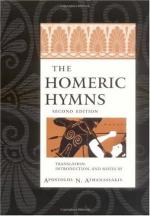Fortunately all Teutons are not so ingenious. Baumeister has fallen on those who, in place of two hymns, Delian and Pythian, to Apollo, offer us half-a-dozen fragments. By presenting an array of discordant conjectures as to the number and nature of these scraps, he demonstrates the purely wilful and arbitrary nature of the critical method employed. {16b} Thus one learned person believes in (1) two perfect little poems; (2) two larger hymns; (3) three lacerated fragments of hymns, one lacking its beginning, the other wofully deprived of its end. Another savant detects no less than eight fragments, with interpolations; though perhaps no biblical critic ejusdem farinae has yet detected eight Isaiahs. There are about ten other theories of similar plausibility and value. Meanwhile Baumeister argues that the Pythian Hymn (our second part) is an imitation of the Delian; by a follower, not of Homer, but of Hesiod. Thus, the Hesiodic school was closely connected with Delphi; the Homeric with Ionia, so that Delphi rarely occurs in the Epics; in fact only thrice (I. 405, [Greek text]. 80, [Greek text]. 581). The local knowledge is accurate (Pythian Hymn, 103 sqq.). These are local legends, and knowledge of the curious chariot ritual of Onchestus. The Muses are united with the Graces as in a work of art in the Delphian temple. The poet chooses the Hesiodic and un-Homeric myth of Heaven and Earth, and their progeny: a myth current also in Polynesia, Australia, and New Zealand. The poet is full of inquiry as to origins, even etymological, as is Hesiod. Like Hesiod (and Mr. Max Muller), origines rerum ex nominibus explicat. Finally, the second poet (and here every one must agree) is a much worse poet than the first. As for the prophetic word of warning to the Crisaeans and its fulfilment, Baumeister urges that the people of Cirrha, the seaport, not of Crisa, were punished, in Olympiad 47 (Grote, ii. 374).
Turning to Gemoll, we find him maintaining that the two parts were in ancient times regarded as one hymn in the age of Aristophanes. {18} If so, we can only reply, if we agree with Baumeister, that in the age of Aristophanes, or earlier, there was a plentiful lack of critical discrimination. As to Baumeister’s theory that the second part is Hesiodic, Gemoll finds a Hesiodic reminiscence in the first part (line 121), while there are Homeric reminiscences in the second part.
Thus do the learned differ among themselves, and an ordinary reader feels tempted to rely on his own literary taste.
According to that criterion, I think we probably have in the Hymn the work of a good poet, in the early part; and in the latter part, or second Hymn, the work of a bad poet, selecting unmanageable passages of myth, and handling them pedantically and ill. At all events we have here work visibly third rate, which cannot be said, in my poor opinion, about the immense mass of the Iliad and Odyssey. The great




